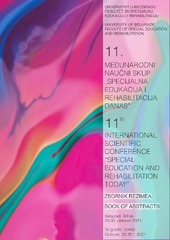Приказ основних података о документу
Kompetentnost učitelja, nastavnika i defektologa za upotrebu asistivne tehnologije u edukaciji učenika sa smetnjama u razvoju
Competence of teachers and special educators in the use of assistive technology in educating students with disabilities
| dc.creator | Jovanović Simić, Nadica | |
| dc.creator | Arsenić, Ivana | |
| dc.creator | Daničić, Zorica | |
| dc.date.accessioned | 2021-10-27T09:52:44Z | |
| dc.date.available | 2021-10-27T09:52:44Z | |
| dc.date.issued | 2021 | |
| dc.identifier.isbn | 978-86-6203-149-5 | |
| dc.identifier.uri | http://rfasper.fasper.bg.ac.rs/handle/123456789/3687 | |
| dc.description.abstract | Uvod: Asistivna tehnologija uključuje širok izbor sredstava i uređaja koji predstavljaju podršku u obrazovanju učenika sa smetnjama u razvoju. Primena tehnologije u nastavi utiče na rad učenika i nastavnika, ishode učenja, kao i na realizaciju nastavnog sadržaja. U savremenoj praksi inkluzivnog obrazovanja, nastavno osoblje mora da poseduje kompetencije za primenu asistivne tehnologije kako bi moglo da zadovolji potrebe učenika sa smetnjama u razvoju u skladu sa njihovim sposobnostima i ograničenjima. Jedno od ključnih pitanja vezanih za primenu asistivne tehnologije u inkluzivnom vaspitno-obrazovnom radu je kakav je nivo znanja i veština nastavnog osoblja u primeni asistivne tehnologije. Cilj: Cilj ovog istraživanja je bio da se utvrdi da li učitelji, nastavnici i defektolozi imaju potrebna znanja i nivo kompetencije za njenu efikasnu upotrebu, kao i da se međusobno uporedi nivo njihove kompetentnosti. Metod: Uzorak je činilo 110 ispitanika oba pola među kojima je bilo 39,1% učitelja i 33,6% nastavnika koji su zaposleni u redovnim osnovnim školama, kao i 19,1% defektologa i 8,2% nastavnika koji su zaposleni u specijalnim osnovnim školama koje se nalaze na teritoriji grada Beograda. Primenjen je upitnik koji je posebno konstruisan za svrhu ovog istraživanja. U obradi podataka korišćena je deskriptivna statistička analiza, kao i testovi statističkog zaključivanja (jednofaktorska analiza varijanse, Pirsonov koeficijent korelacije, t-test). Rezultati: Analiza rezultata je pokazala da su ispitanici umereno kompetentni za primenu asistivne tehnologije u edukaciji osoba sa smetnjama u razvoju. Rezultati statističke analize pokazuju da postoji statistički značajna razlika između nivoa kompetentnosti ispitanika različitog zanimanja (F=9,58; p<0,01). Nije utvrđena statistički značajna razlika u nivou kompetentnosti nastavnog osoblja na osnovu dužine njihovog iskustva u nastavi. | sr |
| dc.description.abstract | Introduction: Assistive technology includes a wide range of tools and devices that support the education of students with disabilities. The application of technology in teaching affects the work of students and teachers, learning outcomes, as well as the realization of teaching content. In the modern practice of inclusive education, educators must be competent in the application of assistive technology in order to be able to meet the needs of students with disabilities in accordance with their abilities and limitations. One of the key issues related to the application of assistive technology in inclusive education is the level of knowledge and skills of educators in the application of assistive technology. Aim: The aim of this research was to determine whether teachers and special educators have the necessary knowledge and level of competence for its effective use, as well as to compare the level of their competence. Method: The sample consisted of 110 respondents of both genders, among whom there were 39.1% of lower-grade teachers and 33.6% of upper-grade teachers employed in regular primary schools, as well as 19.1% of special educators and 8.2% of teachers employed in special primary schools in Belgrade. A questionnaire specially designed for the purpose of this research was applied. Descriptive statistical analysis was used in data processing, as well as statistical inference tests (univariate analysis of variance, Pearson’s correlation coefficient, t-test). Results: The analysis of the results showed that the respondents were moderately competent in the application of assistive technology in the education of people with disabilities. The results of statistical analysis showed that there was a statistically significant difference between the levels of competence of the respondents with different occupations (F=9.58; p<.01). No statistically significant difference was found in the level of competence of educators with regard to the length of their teaching experience. Conclusion: The results suggest that the respondents possess different levels of knowledge and skills for the use of assistive technology, as well as that there is a lack of training in this area. | sr |
| dc.language.iso | sr | sr |
| dc.language.iso | en | sr |
| dc.publisher | Univerzitet u Beogradu – Fakultet za specijalnu edukaciju i rehabilitaciju / University of Belgrade – Faculty of Special Education and Rehabilitation | sr |
| dc.rights | openAccess | sr |
| dc.rights.uri | https://creativecommons.org/licenses/by-sa/4.0/ | |
| dc.source | Zbornik rezimea – 11. Međunarodni naučni skup „Specijalna edukacija i rehabilitacija danas“, Beograd, Srbija, 29–30.10.2021 | sr |
| dc.subject | asistivna tehnologija | sr |
| dc.subject | edukacija | sr |
| dc.subject | kompetentnost nastavnog osoblja | sr |
| dc.subject | assistive technology | sr |
| dc.subject | education | sr |
| dc.subject | educators’ competence | sr |
| dc.title | Kompetentnost učitelja, nastavnika i defektologa za upotrebu asistivne tehnologije u edukaciji učenika sa smetnjama u razvoju | sr |
| dc.title | Competence of teachers and special educators in the use of assistive technology in educating students with disabilities | sr |
| dc.type | conferenceObject | sr |
| dc.rights.license | BY-SA | sr |
| dc.citation.epage | 83 | |
| dc.citation.spage | 82 | |
| dc.identifier.fulltext | http://rfasper.fasper.bg.ac.rs/bitstream/id/3814/bitstream_3814.pdf | |
| dc.identifier.rcub | https://hdl.handle.net/21.15107/rcub_rfasper_3687 | |
| dc.type.version | publishedVersion | sr |


